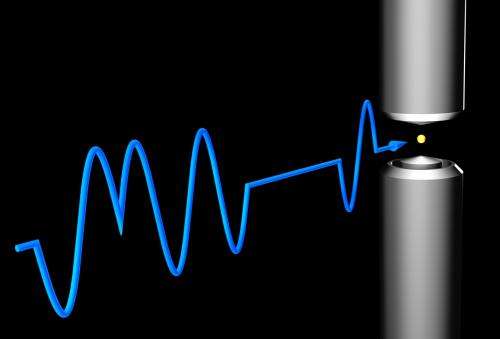New technique excites atoms and molecules using pulsed laser

The best method to obtain the most precise information on the inner structure of atoms and molecules is to excite them by means of resonant laser light. Unfortunately, just this laser light (above a certain intensity) can lead to measurable modifications within the atom's electron shell. Scientists of the Physikalisch-Technische Bundesanstalt (PTB) have now shown experimentally how to prevent such "light shifts". This confirms the advantages of "hyper" Ramsey excitation that had already been predicted theoretically. This method can make their optical ytterbium atomic clocks even more accurate. Furthermore, "hyper" Ramsey excitation can be helpful in numerous applications where the focus lies on a precise, controlled interaction between atoms and laser light. The results have been published in the current issue of the scientific journal Physical Review Letters.
"Light shift" means that intense laser light modifies the position of the atomic energy levels; the shift depends on the intensity and the wavelength of the laser used. If one is seeking the properties of the atom as an undisturbed quantum object, this shift must be either prevented or corrected. With the new procedure, which has been applied experimentally for the first time at PTB, a sequence of judiciously selected laser pulses used to excite the atom eliminates the disturbing light shift effect.
The basic idea of using pulsed radiation to perform precise measurements goes back to Norman Ramsey, who was awarded the Nobel Prize in physics in 1989 for this finding. With this method, a first laser pulse is shot at the atom, where it starts a resonant excitation. Then the pulsation excited in the electron shell of the atom continues undisturbed "in the dark" until eventually a second laser pulse completes the comparison between the resonance frequency of the atom and the laser frequency. A similar approach is also usual in clock comparisons: two clocks are set to the same time, they are then left to run on and are eventually compared again. The result shows which clock was faster or slower than the other.
The signal of the Ramsey excitation contains, due to the dark phase between the laser pulses, an averaging over the positions of the states of the atom with and without a light shift. In principle, it would be possible to compensate for the light shift by modifying the laser frequency by exactly this quantity (exclusively) during the pulses. This, however, would not bring great improvement from a practical point of view as the precise information concerning the disturbance of the atom should be known to begin with. In 2010, a group of scientists (also with PTB's participation) suggested a method they called "hyper" Ramsey excitation in order to solve this problem. This theoretical consideration has now been confirmed experimentally for the first time. In the case of "hyper" Ramsey excitation, a third laser pulse of the same intensity and the same frequency, but with an inverted phase, is inserted into the dark phase. This third laser pulse automatically compensates for possible errors which could occur due to misjudgment as regards the size of the light shift and due to small variations in the laser intensity during the light pulses.
Realizing "hyper" Ramsey excitation experimentally succeeded in an atomic transition which allows very slight frequency variations to be detected and, at the same time, exhibits a large light shift, since a high laser intensity is necessary for its excitation. It is an electrical octupole transition in the Yb+ ion which is being investigated as a basis for an optical clock. The experiment confirmed the theoretical predictions concerning the advantages of "hyper" Ramsey excitation and attained a 10,000-fold suppression of the light shift. This opens up the possibility for the optical Yb+ clock to achieve even greater accuracy. This method could also be interesting for other researchers trying to obtain a precisely controlled interaction between atoms and laser light, for instance in the field of quantum information processing.
This allows them to remove an important obstacle in the development of even better optical atomic clocks, because the stability of the lasers used is a critical point. The "pendulum", i.e. the swinging system of such a clock, is a narrow optical absorption line in an atom or ion, whose transition frequency is read out by a laser. The linewidth of these transitions typically amounts to a few millihertz, a value which could not be reached by glass resonators due to their limited length stability.
But this is now possible. The laser to which the silicon resonator is stabilized reaches a linewidth of less than 40 mHz and can, thus, contribute to moving into a new dimension in the development of optical atomic clocks. This work could also benefit optical precision spectroscopy, another focal point of research of the Excellence Cluster QUEST.
"For the future, there is still room to improve the optical mirrors whose thermal noise limits the achievable stability", explains PTB physicist Christian Hagemann. Therefore, the researchers will in future go down to even lower temperatures and use novel highly reflecting structures to improve the frequency stability by another order of magnitude.
More information: Huntemann, N.; Lipphardt, B.; Okhapkin, M.; Tamm, Chr.; Peik, E.; Taichenachev, A.V.; Yudin, V.I: Generalized Ramsey excitation scheme with suppressed light shift. Phys. Rev. Lett. 109 (2012) 213002. link.aps.org/doi/10.1103/PhysRevLett.109.213002
Journal information: Physical Review Letters
Provided by Physikalisch-Technische Bundesanstalt
















